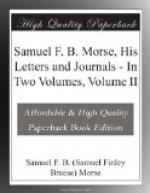Morse’s opportunity to do public honor to Henry came in 1848, when Professor Sears C. Walker, of the Coast Survey, published a report containing some remarks on the “Theory of Morse’s Electro-Magnetic Telegraph.” When Professor Walker submitted this report to Morse the latter said: “I have now the long-wished-for opportunity to do justice publicly to Henry’s discovery bearing upon the telegraph. I should like to see him, however, previously, and learn definitely what he claims to have discovered. I will then prepare a paper to be appended and published as a note, if you see fit, to your Report.”
This paper was written by Morse and sent to Professor Walker with the request that it be submitted to Professor Henry for his revision, which was done, but it was not included in Professor Walker’s report, and this naturally nettled Morse, who also had sensitive nerves, and so the breach was widened. In this paper, after giving a brief history of electric discoveries bearing on the telegraph, and of his own inventions, Morse sums up:—
“While, therefore, I claim to be the first to propose the use of the electro-magnet for telegraphic purposes, and the first to construct a telegraph on the basis of the electro-magnet, yet to Professor Henry is unquestionably due the honor of the discovery of a fact in science which proves the practicability of exciting magnetism through a long coil or at a distance, either to deflect a needle or to magnetize soft iron.”
I wish he had never revised this opinion, although he was sincere in thinking that a more careful study of the subject justified him in doing so.
A few years afterwards Morse and his associates became involved in a series of bitterly contested litigations with parties interested in breaking down the original patent rights, and Henry was called as a witness for the opponents of Morse.
He gave his testimony with great reluctance, but it was tinged with the bitterness caused by the failure of Vail to do him justice and his apparent conviction that Morse was disingenuous. He denied to the latter any scientific discoveries, and gave the impression (at least, to others) that Henry, and not Morse, was the real inventor of the telegraph. His testimony was used by the enemies of Morse, both at home and abroad, to invalidate the claims of the latter, and, stung by these aspersions on his character and attainments, and urged thereto by injudicious friends, Morse published a lengthy pamphlet entitled: “A Defense against the Injurious Deductions drawn from the Deposition of Professor Joseph Henry.” In this pamphlet he not only attempted to prove that he owed nothing to the discoveries of Henry, but he called in question the truthfulness of that distinguished man.
The breach between these two honorable, highly sensitive men was now complete, and it was never healed.




